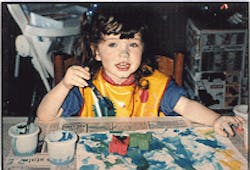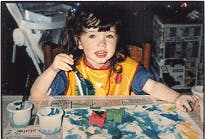Lessons learned from my daughter
My 5-year-old daughter`s ideas were simple, yet profound. Lesson No. 1 was to put fewer balls in the air so there is less to juggle.
Michael Morgan, DDS
Dentists today are bombarded with suggestions on how to properly manage their practices. Management companies, journal articles, seminars, and peers offer a myriad of advice on a complex and often confusing subject. Many claim to have the correct or best system when, in fact, there are countless different methods to successfully manage a dental practice.
Throughout my dental career, I have used all of the aforementioned sources in an effort to make my practice less stressful, more efficient, and more profitable. After years of expensive and sometimes questionable advice, I discovered a practice-management adviser whose ideas were simple, yet profound. The compensation requirement for this advice was surprisingly small - an enthusiastic, warm hug and an occasional bubble gum ice cream cone. My high-priced consultant is my 5-year-old daughter, Brittany.
What follows are just a few of the lessons she has taught me over the past three years. These lessons have revolutionized my practice and my life.
Lesson No. 1 - Simplify your juggling and your life. In 1994, I sold my rural Illinois practice and opened a new scratch practice in the northwest suburbs of Chicago. Like most dentists, I thought bigger was better. I built a large group facility in anticipation of fast growth.
In less than six months, three general dentists and three specialists were needed to treat over 290 new patients per month. The office was open a minimum of 12 hours a day, six days a week. Doctors and staff worked single or double six-hour shifts to accommodate patient demand.
From the statistics that most dentists use to measure success (i.e., new patients and gross production per month), the practice appeared prosperous. However, the time and energy spent managing the practice was leading to my emotional bankruptcy and professional burnout.
One weekend two years ago, I took my daughter to the County Fair. Among the many exhibitions and attractions was a man juggling plastic balls that were in bright primary colors. The juggler started with two balls, which seemed relatively easy. Each time he added another ball, he seemed less relaxed. By the time he reached eight balls in the air together, his relaxed stance and smile had been replaced by rigid posture and a stressed expression.
My daughter noticed his emotional change right away. "So many balls, he`s now sad," she said as he struggled to maintain his complicated juggling.
A similar phenomenon occurs as a dental practice grows. At first, the doctor is able to devote his attention to balancing or juggling the two most important priorities he has - his family and his practice. However, as the practice grows, there are more responsibilities, such as the need for more staff, more patients, insurance reimbursement, accounts receivable, marketing, adequate new-patient flow, continuing education, recall systems, case presentation, failed appointments, telephone control, productivity, payroll, accounts payable, and literally dozens more.
My daughter`s simple observation was the key to lowering the stress in any practice - simplify the practice so there is less for the doctor to juggle. As the senior dentist, I started by downsizing the office to a few key staff members and myself. We began to treat a smaller number of patients per day, but we spent much more time with each individual patient.
At the same time, I began taking courses at the Baylor Aesthetic Continuum and The Las Vegas Institute to strengthen my skills in newer services. With fewer procedures offered, a much smaller staff, fewer new patients, insurance independence, and delegation of most duties to my staff, I was able to maintain my primary focus on my family and my practice.
Surprisingly enough, over the two-year period these changes occurred, our gross production was close to that of the six-doctor group practice, while net income and overall professional satisfaction increased substantially.
Lesson No. 2 - You have choices, so do what you like to do and then strive to become the best at what you like the most. Children have an innate ability to focus their attention on people, places, and things they like. They do not get up each morning with the idea of making themselves miserable. They choose activities that make them happy and they are very vocal about being coerced into activities they do not enjoy.
My daughter loves to paint. We go through more artists` paper and paint in a week than most families do in a lifetime. Brittany has other interests and enjoys other activities, but none compares with art. Even at her young age, her passion for art is readily apparent.
About a year ago, she wanted to learn some new painting techniques, so she asked my wife - a talented artist herself - for some guidance. My wife began to teach Brittany techniques she learned from her own painting instructors. In a sense, Brittany has found a mentor for her own favorite activity.
Dentists seem to do just the opposite. They spend an enormous amount of time performing procedures they do not enjoy and working days and hours they do not enjoy either. They allow insurance companies, demanding patients, and difficult staff members to add chaos and stress to their lives.
Dentists create an environment that makes them miserable, but refuse to accept responsibility for their choices.
Every dental practice is a direct reflection of the vision of the dentist that owns it. It is very important to understand that you have choices. You choose your office hours, the services offered, the number of days worked, the fee schedule, the manner of patient payment, etc. For example, if you don`t enjoy doing endo, then simply don`t do it! There is no rule or law that says you must do every procedure that a dental license allows you to do.
Find the area of dentistry that you really enjoy and strive to become the best in that area. Whether it is endo, ortho, perio, surgery, restorative, or cosmetic, if you really enjoy what you do, it will seem more like play than work. Use continuing education and many of the excellent teaching institutions available to help you improve your skills.
Find a mentor to guide you and help you develop your expertise and enjoyment. Join organizations where you can spend time and share ideas with doctors whose interests are similar to yours.
No law says that you must be open nights and weekends, take little or no time off, charge low fees, or accept insurance. To those who say we have a "responsibility" to provide whatever services our patients want when they want it and at the fee they want to pay, I say, "Baloney!"
Your most important responsibility is to your family. That means doing procedures you enjoy on days and during hours you want to work. That means working with staff you like to work with on patients you want to treat at a fee you feel is fair compensation for your time and expertise.
Do not set up your practice so that you are miserable every day! Set it up so you genuinely look forward to going to your office when you choose to do so.
Lesson No. 3 - Do not just tell people you care; show them you do. One of the best parts of being the father is a big, loving hug from your child after a long workday. Children often will say exactly how they feel about someone. More often, they show it through their actions.
Whenever a family member is feeling ill or blue, Brittany asks me if she can pick some flowers to give to that person. She knows that words can make people feel better. She also realizes that a small gesture - such as giving flowers - really can touch a person`s heart.
As dentists, sometimes we forget that there is a person with feelings and emotions attached to the teeth that we are treating. Practice-management consultants recommend all sorts of dialogues and scripts for us to use to make our patients feel more at ease. Many such tools work well and are worthwhile additions to our communication skills. However, actions speak volumes more to patients than mere words.
Seemingly small gestures can show patients that you truly have their best interests and comfort in mind. Examples of such "little things" include not keeping patients waiting, comfortable operatory chairs, pre-op anti-inflammatory medications, showing genuine concern during treatment, bite blocks for long appointments, massage therapy during or after treatment, and assistance in freshening up at the end of the appointment.
This also sets you apart from the managed-care masses and increases patient retention and the likelihood that patients will refer others to your office.
The easiest and most successful method to demonstrate your level of concern is one that has been recommended for decades, but which still is only used by about 10 percent of dentists. After work, call to check on the patient`s comfort. It is so simple and so easy to do, yet so powerful in terms of the impression it makes on your patients.
Another way to show patients your genuine concern is to ask questions. Find out what your patients want, assure them you can give it to then, then deliver service beyond their expectations. It is a simple recipe for success used by businesses from sole proprietorships to Fortune 500 companies.
Lesson No. 4 - Never stop asking. If you do not a-s-k, you do not g-e-t.
Children consistently are asking questions. They are like little question machines that never stop. Some questions come from curiosity. Other questions test the limitations of their parents and their environment. Children more often think, "Why?" instead of "Why not?"
I have noticed that my daughter will repeat questions until she gets a satisfactory answer. Children have little fear of rejection. They have a great deal of what Greg Stanley calls "confrontational tolerance."
As dentists, we have been taught just the opposite. "No" from a patient means "no" and do not dare ask again. In actuality, "no" may mean "Not at this particular time," or "I am not ready to decide now," or "I do not fully understand the question or choices."
After presenting a treatment plan, most dentists never ask patients if they would like the treatment done. If they do ask and receive a negative reply, most dentists never ask again for fear of additional rejections. They may not even ask the next patient in the chair because of the same fear!
The average dental patient in the U.S. today has approximately $400 of dental treatment done each year. That is a staggeringly small amount, given the problems, concerns, and desires most patients bring into our offices. Ever wonder why one dentist may average $500 per patient per year, while another dentist next door has patients accepting and completing treatment plans carrying fees of $10,000 to $50,000.
Doctors with higher treatment acceptance take a child-like approach. They ask the patient to accept treatment without fear of rejection. First, they find out what patients want. They ask a question, sit back, shut up, and listen to everything the patient has to say. The key to finding out what your patients want is to listen to them.
Forget about telling patients what you think they need. The dental school method of treatment recommendations is archaic, irrelevant, and insulting today. Patients spend their incomes on what they want, not what they need. Sure, you can try to educate patients on the logic of certain procedures; but, in the end, they will buy what they want.
And the only way to find out what your patients want is to ask and listen.
For more information about this article, contact the author at [email protected].
The teacher, 5-year-old Brittany Morgan.

